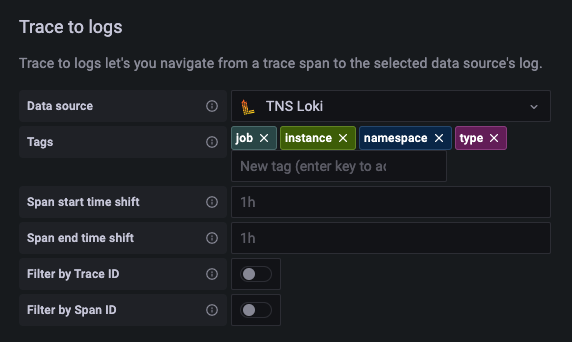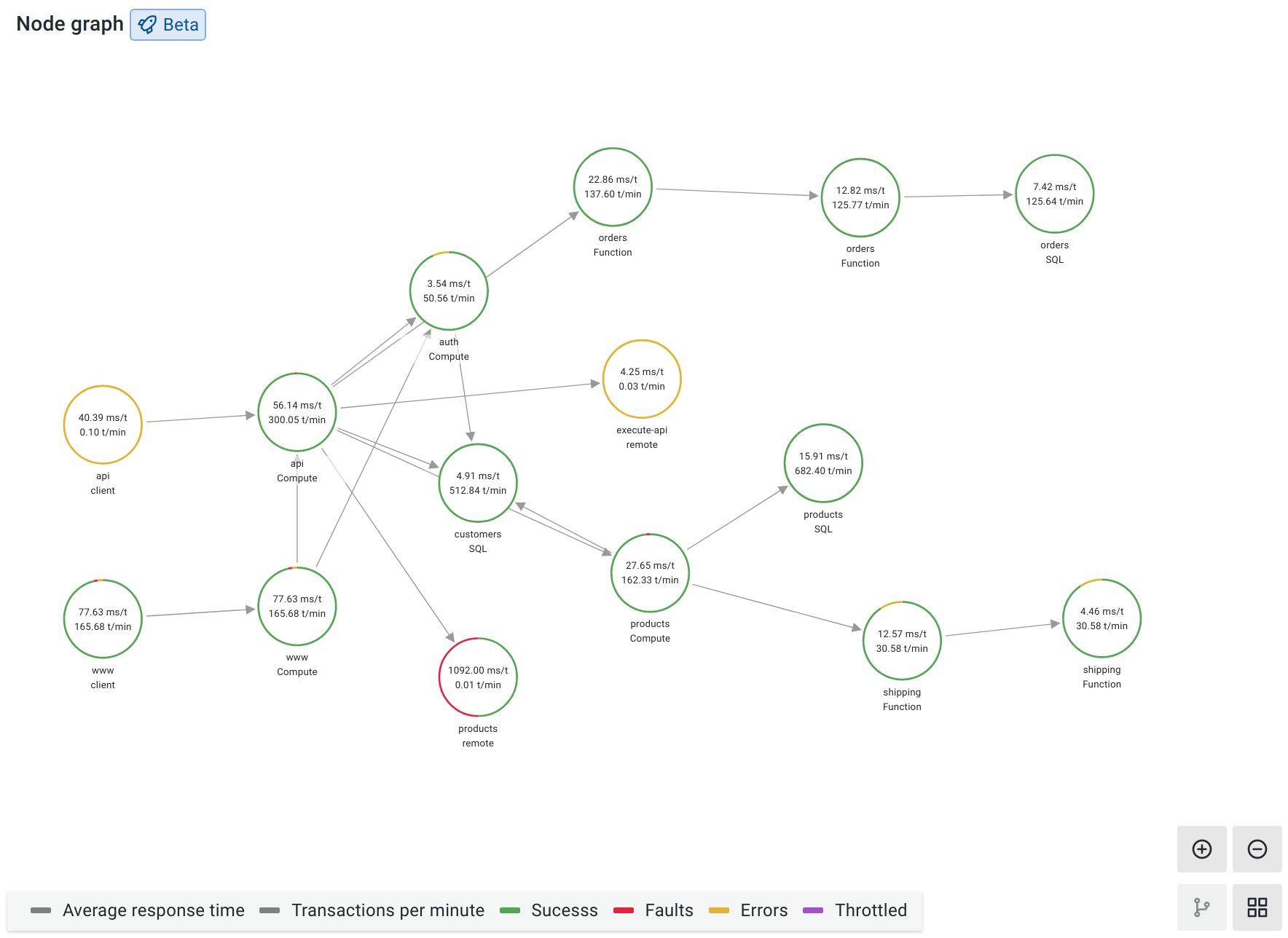Important: This documentation is about an older version. It's relevant only to the release noted, many of the features and functions have been updated or replaced. Please view the current version.
Tempo data source
Grafana ships with built-in support for Tempo, a high-volume, minimal-dependency trace storage, open-source tracing solution from Grafana Labs.
For instructions on how to add a data source to Grafana, refer to the administration documentation. Only users with the organization administrator role can add data sources. Administrators can also configure the data source via YAML with Grafana’s provisioning system.
Once you’ve added the data source, you can configure it so that your Grafana instance’s users can create queries in its query editor when they build dashboards and use Explore.
You can also use the service graph to view service relationships, track Application Performance Management metrics, upload a JSON trace file, and link a trace ID from logs in Loki or Elasticsearch.
Configure the data source
To access the data source configuration page:
- Hover the cursor over the Configuration (gear) icon.
- Select Data Sources.
- Select the Tempo data source.
Set the data source’s basic configuration options carefully:
You can also configure settings specific to the Tempo data source:
Configure trace to logs

Note: Available in Grafana v7.4 and higher. If you use Grafana Cloud, open a support ticket in the Cloud Portal to access this feature.
The Trace to logs setting configures the trace to logs feature available when integrating Grafana with Tempo.
To configure trace to logs:
- Select the target data source.
- Select which tags to use in the logs query.
Configure trace to metrics
Note: This feature is behind the
traceToMetricsfeature toggle. If you use Grafana Cloud, open a support ticket in the Cloud Portal to access this feature.
The Trace to metrics setting configures the trace to metrics feature available when integrating Grafana with Tempo.
To configure trace to metrics:
- Select the target data source.
- Create any desired linked queries.
Each linked query consists of:
- Link Label: (Optional) Descriptive label for the linked query.
- Query: The query ran when navigating from a trace to the metrics data source.
Interpolate tags using the
$__tagskeyword. For example, when you configure the queryrequests_total{$__tags}with the tagsk8s.pod=podandcluster, the result looks likerequests_total{pod="nginx-554b9", cluster="us-east-1"}.
Configure service graph
The Service Graph section configures the Service Graph feature.
Configure the Data source setting to define in which Prometheus instance the Service Graph data is stored.
To use the service graph, refer to the Service graph section.
Configure Tempo search integration
The Search section configures Tempo search.
Optionally configure the Hide search setting to hide the search query option in Explore if search is not configured in the Tempo instance.
Enable Node Graph
The Node Graph setting enables the beta Node Graph visualization, which is disabled by default.
Once enabled, Grafana displays the Node Graph after loading the trace view.
Configure Loki search
The Loki search section configures the Loki search query type.
Configure the Data source setting to define which Loki instance you want to use to search traces. You must configure derived fields in the Loki instance.
Span bar label
The Span bar label section helps you display additional information in the span bar row.
You can choose one of three options:
Provision the data source
You can define and configure the Tempo data source in YAML files as part of Grafana’s provisioning system. For more information about provisioning, and for available configuration options, refer to Provisioning Grafana.
Provisioning examples
apiVersion: 1
datasources:
- name: Tempo
type: tempo
# Access mode - proxy (server in the UI) or direct (browser in the UI).
access: proxy
url: http://localhost:3200
jsonData:
httpMethod: GET
tracesToLogs:
datasourceUid: 'loki'
tags: ['job', 'instance', 'pod', 'namespace']
mappedTags: [{ key: 'service.name', value: 'service' }]
mapTagNamesEnabled: false
spanStartTimeShift: '1h'
spanEndTimeShift: '1h'
filterByTraceID: false
filterBySpanID: false
tracesToMetrics:
datasourceUid: 'prom'
tags: [{ key: 'service.name', value: 'service' }, { key: 'job' }]
queries:
- name: 'Sample query'
query: 'sum(rate(tempo_spanmetrics_latency_bucket{$__tags}[5m]))'
serviceMap:
datasourceUid: 'prometheus'
search:
hide: false
nodeGraph:
enabled: true
lokiSearch:
datasourceUid: 'loki'Query the data source
The Tempo data source’s query editor helps you query and display traces from Tempo in Explore.
For details, refer to the query editor documentation.
Upload a JSON trace file
You can upload a JSON file that contains a single trace and visualize it. If the file has multiple traces, Grafana visualizes its first trace.
To download a trace or service graph through the inspector:
- Open the inspector.
- Navigate to the Data tab.
- Click Download traces or Download service graph.
Trace JSON example
{
"batches": [
{
"resource": {
"attributes": [
{ "key": "service.name", "value": { "stringValue": "db" } },
{ "key": "job", "value": { "stringValue": "tns/db" } },
{ "key": "opencensus.exporterversion", "value": { "stringValue": "Jaeger-Go-2.22.1" } },
{ "key": "host.name", "value": { "stringValue": "63d16772b4a2" } },
{ "key": "ip", "value": { "stringValue": "0.0.0.0" } },
{ "key": "client-uuid", "value": { "stringValue": "39fb01637a579639" } }
]
},
"instrumentationLibrarySpans": [
{
"instrumentationLibrary": {},
"spans": [
{
"traceId": "AAAAAAAAAABguiq7RPE+rg==",
"spanId": "cmteMBAvwNA=",
"parentSpanId": "OY8PIaPbma4=",
"name": "HTTP GET - root",
"kind": "SPAN_KIND_SERVER",
"startTimeUnixNano": "1627471657255809000",
"endTimeUnixNano": "1627471657256268000",
"attributes": [
{ "key": "http.status_code", "value": { "intValue": "200" } },
{ "key": "http.method", "value": { "stringValue": "GET" } },
{ "key": "http.url", "value": { "stringValue": "/" } },
{ "key": "component", "value": { "stringValue": "net/http" } }
],
"status": {}
}
]
}
]
}
]
}Use the service graph
A service graph is a visual representation of the relationships between services. Each node on the graph represents a service such as an API or database.
You use a service graph to detect performance issues; track increases in error, fault, or throttle rates in services; and investigate root causes by viewing corresponding traces.

To display the service graph:
- Configure Grafana Agent or Tempo or GET to generate service graph data.
- Link a Prometheus data source in the Tempo data source’s Service Graph settings.
- Navigate to Explore.
- Select the Tempo data source.
- Select the Service Graph query type.
- Run the query.
- (Optional) Filter by service name.
For details, refer to Node Graph panel.
Each circle in the graph represents a service. To open a context menu with additional links for quick navigation to other relevant information, click a service.
Numbers inside the circles indicate the average time per request and requests per second.
Each circle’s color represents the percentage of requests in each state:
View the APM table
The Application Performance Management (APM) table lets you view several APM metrics out of the box. The APM table is part of the APM dashboard.

For details, refer to the APM dashboard documentation.
To display the APM table:
- Activate the
tempoApmTablefeature toggle in yourgrafana.inifile. - Link a Prometheus data source in the Tempo data source settings.
- Navigate to Explore.
- Select the Tempo data source.
- Select the Service Graph query type and run the query.
- (Optional) Filter your results.
Note: Grafana uses the
traces_spanmetrics_calls_totalmetric to display the name, rate, and error rate columns, andtraces_spanmetrics_latency_bucketto display the duration column. These metrics must exist in your Prometheus data source.
To open a query in Prometheus with the span name of that row automatically set in the query, click a row in the rate, error rate, or duration columns.
To open a query in Tempo with the span name of that row automatically set in the query, click a row in the links column.
Link a trace ID from logs
You can link to Tempo trace from logs in Loki or Elasticsearch by configuring an internal link.
To configure this feature, see the Derived fields section of the Loki data source docs, or the Data links section of the Elasticsearch data source docs.



